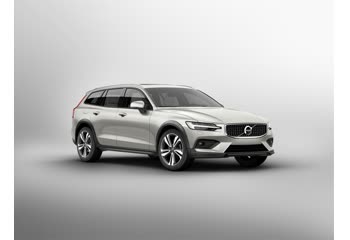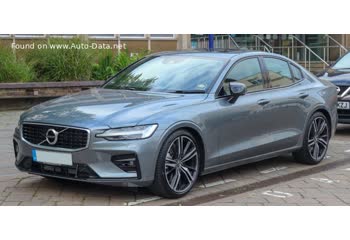Everything you need to know about specifications and performance - Volvo V60 2019 - 2.0 T8 TwEn (303 Hp) Plug-in Hybrid AWD Geartronic

Overview:
What is the engine capacity of a Volvo V60 2019?
The engine capacity of the Volvo V60 2019 is 1969.
Volvo V60 2019 How many horsepower?
The engine power of the Volvo V60 2019 is 303 Hp @ 6000 rpm..
What is the Volvo V60 2019 engine?
Volvo V60 2019 engine is B4204T34. (Click to see other cars using the same engine)
How much gasoline does a Volvo V60 2019 consume?
The Volvo V60 2019 consumes 1.7-1.8 liters of gasoline per 100 km
General:
Brand: Volvo
Model: V60
Generation: V60 II
Modification (Engine): 2.0 T8 TwEn (303 Hp) Plug-in Hybrid AWD Geartronic
Start of production: April, 2019
End of production: September, 2021
Powertrain Architecture:Plug-In Hybrid Electric Vehicles (PHEVs)
Body type:Station wagon
Seats: 5
Doors: 5
Engine:
Engine systems: Start & Stop System
Power: 303 hp @ 6000 rpm.
Power per litre: 153.9 hp/l
Torque: 400 nm @ 2200-4800 rpm.
Engine Model/Code:B4204T34
Engine displacement: 1969
Number of cylinders: 4
Engine configuration: Inline
Number of valves per cylinder: 4
Fuel injection system: Direct injection
Engine aspiration: turbocharging and Supercharger, Intercooler
Valvetrain: DOHC
Engine oil capacity: 5.6 l
Engine layout: Front, Transverse
Cylinder Bore: 82 mm
Piston Stroke: 93.2 mm
Compression ratio: 10.3:1
Performance:
Fuel Type: Petrol / electricity
Combined fuel consumption (WLTP): 1.7-2.4 l/100 km
Fuel consumption (economy) - combined (NEDC): 1.7-1.8 l/100 km
Fuel consumption (economy) - combined: 1.7-1.8 l/100 km
Emission standard: Euro 6d-TEMP
Acceleration 0 - 100 km/h: 4.9 sec
Acceleration 0 - 62 mph: 4.9 sec
Maximum speed: 250 km/h
Weight-to-power ratio: 6.6 kg/Hp, 152.6 Hp/tonne
Weight-to-torque ratio: 5 kg/Nm, 201.4 Nm/tonne
Max speed (electric): 125 km/h
Acceleration 0 - 60 mph: 4.7 sec
Electric system:
Gross battery capacity: 11.6 kWh
Battery technology: Lithium-ion (Li-Ion)
Battery location: In the central tunnel
All-electric range: 50-59 km
Electric motor power: 87 hp @ 7000 rpm.
Electric motor Torque: 240 nm @ 0-3000 rpm.
Average Energy consumption: 15.7-16.6 kWh/100 km
Electric motor location: Rear axle, Transverse
Average Energy consumption (WLTP): 15.7-16.6 kWh/100 km
All-electric range (WLTP): 50-59 km
Battery voltage: 400 V
Average Energy consumption (NEDC): 15.8-16.5 kWh/100 km
All-electric range (NEDC): 54-56 km
Space:
Kerb Weight (kg): 1986
Max. weight (kg): 2550
Max. roof load: 75 kg
Max load (kg): 564
Trunk (boot) space - maximum: 1441 l
Trunk (boot) space - minimum: 529 l
Permitted trailer load with brakes (12%): 2000 kg
Fuel tank capacity: 60 l
Permitted trailer load without brakes: 750 kg
Permitted towbar download: 100 kg
dimensions:
Length: 4761 mm
Width: 1850 mm
Height: 1427 mm
wheelbase: 2872 mm
Width with mirrors folded: 1916 mm
Width including mirrors: 2040 mm
Front track: 1610 mm
Rear (Back) track: 1610 mm
Front overhang: 848 mm
Rear overhang: 1041 mm
Ride height (ground clearance): 128 mm
Minimum turning circle (turning diameter): 11.3 m
Powertrain, Suspension and Brakes:
Drivetrain Architecture: The Internal combustion Engine (ICE) permanently drives the front wheels of the vehicle, the electric motor drives the rear wheels of the vehicle, capable of running in full electric mode, only by the Internal combustion Engine (ICE) or in mixed mode.
Drive wheel: All wheel drive (4x4)
Number of gears and type of gearbox: 8 gears, automatic transmission Geartronic
Front brakes: Ventilated discs, 345x30 mm
Rear brakes: Ventilated discs, 320x20 mm
Assisting systems: ABS (Anti-lock braking system)
Steering type: Steering rack and pinion
Power steering: Electric Steering
Tires size: 235/45 R18; 235/40 R19
Wheel rims size: 8J x 18; 8J x 19
Front suspension: Double wishbone, Transverse stabilizer
Rear suspension: Transverse stabilizer, Leaf Spring
See also

Last generation.
Its production began in 2020 until Now

Other generation.
Its production began in 2011 until 2013

Same engine. (B4204T34).
Its production began in 2019 until 2021

Same engine. (B4204T34).
Its production began in 2020 until 2021

Same engine. (B4204T34).
Its production began in 2018 until 2019
Write a comment